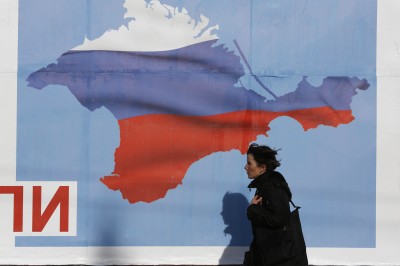The Geopolitics of Border Walls and Fences. Russia’s Crimea-Ukraine Fence
Analysis of Russia’s Fence Along Its Crimea/Ukraine Border

Walls are about exclusion, not inclusion, often falling way short of security they’re built to provide.
The Great Wall of China fortifications is best known, construction begun over 2,000 years ago, most of it dating from the Ming dynasty (1368 – 1644), built to protect against Mongols and other hostile invaders.
Nearly 1,000 miles in length, its deterrence was spotty, often failing to keep enemies out as intended. Today the Great Wall is an artifact of history.
According to the Migration Policy Institute (MPI), border walls were built or are being built by numerous countries – including Austria, Bulgaria, Estonia, France, Hungary, Israel, Kenya, Norway, Pakistan, Saudi Arabia, Tunisia, and elsewhere.
Aside from the Great Wall of China and Berlin Wall (1961 – 1989), border walls, fences and barriers are “a recent historical trend, arising in response to the growth in spontaneous international migration,” said MPI.
According to Geography Professor Elisabeth Vallet, there were fewer than five border walls in the world when WW II ended. Nearly 70 exist today, a disturbing trend.
Walls are no deterrents to military forces. France’s heavily fortified Maginot Line failed to deter Nazi aggression, its forces circumventing the fortifications, conquering France in six weeks, emboldening Hitler to believe he was invincible, soon enough to learn otherwise.
According to MPI, the ability of walls to keep out unwanted migrants, refugees and asylum seekers is mixed at best.
When short in length and heavily guarded, they work. Longer walls and fences are vulnerable to penetration in remote, less well guarded areas.
The entire near-2,000 mile-long US Mexican border is too lengthy to be guarded well enough to keep out unwanted aliens.
When land routes were closed to refugees in Europe, they went by sea to desired locations, risking their lives to get there.
MPI explained that when “easier routes are closed, (aliens) choose ever more dangerous paths to reach their destination.”
Along the US border with Mexico, aliens cross hazardous desert terrain to reach America, hundreds perishing annually, thousands unsuccessfully able to cross the Mediterranean Sea to Europe each year.
Despite the dangers, migrants, refugees, and asylum seekers continue to seek ways to cross borders for safety, well-being, and opportunities absent in their homelands.
The US/Mexican border has fencing covering around one-third of its route. Walls covering large distances are more symbolic than deterrents to aliens seeking new destinations.
According to MPI, “despite the expense and questionable effectiveness, it seems likely that in the short term there will be many more walls going up around the world.”
“What remains to be seen, however, is how long they will stay up” – and whether their cost will eventually outweigh their ineffectiveness.
In December, Russia completed construction of a 37-mile fence, separating Crimea from Ukraine, according to the Federal Security Service’s (FSB) Border Service for Russia’s Republic of Crimea and Sevastopol.
Construction cost 200 million rubles, less that $3 million at the current exchange rate. At an equivalent cost-per-mile along the near-2,000 mile US/Mexico border, a similar barrier could be built for about $150 million – including “an intricate system of (visible and hidden) alarm sensors,” according to Russia’s Border Service, along with visual surveillance along its entirety.
Russian efficiency and effectiveness are notable compared to notorious US waste, fraud and abuse, countless trillions of dollars wasted at the expense of vital homeland needs.
Russia’s Crimea structure along the Ukrainian border includes several types of barricades. Vibration sensors go off when anyone approaches the barrier, security personnel alerted to the intruder’s location.
Radioray sensors activate night-vision security cameras, a video feed, and an alarm when anyone approaches a detection zone – followed by an audible warning.
Russia’s system aims to deter Ukrainian saboteurs from infiltrating Crimean territory, along with wanting to prevent illegal trafficking of weapons, munitions, illicit drugs and other goods authorities want kept out.
A similar system is used in Russia’s Far East, as well as other areas along its borders. It’s believed the barrier and sophisticated equipment can withstand harsh climate conditions for at least 10 years.
No system is foolproof. Ways are usually found to breach barriers. The fulness of time will tell if Russian technology performs as intended.
*
Note to readers: please click the share buttons above. Forward this article to your email lists. Crosspost on your blog site, internet forums. etc.
Award-winning author Stephen Lendman lives in Chicago. He can be reached at [email protected]. He is a Research Associate of the Centre for Research on Globalization (CRG)
His new book as editor and contributor is titled “Flashpoint in Ukraine: US Drive for Hegemony Risks WW III.”
http://www.claritypress.com/LendmanIII.html
Visit his blog site at sjlendman.blogspot.com.

